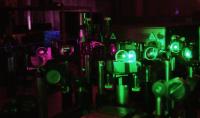Recipe for real 3D imaging

The research was done by Professor Michał Makowski and Professor Andrzej Stupakiewicz from Białystok University
Researchers from the Faculty of Physics of the Warsaw University of Technology and Białystok University, thanks to their cooperation with Japanese and Dutch scientists, have proposed a novel method of recording 3D holographic images. The results of their work were published in „Nature Communications”.
Development of real 3D and scalable displays is still one of the greatest challenges of modern physics. A solution the usable electronics industry has long been waiting for must have perfect image quality and the possibility of watching spatial images in a fully natural way for a long time. So-called 3D TVs failed to meet these requirements, which was painful for users – advanced stereoscopic technology was in fact an attempt of imposing on the viewer’s brain an artificial impression of image spatiality for a long time.
What is then the essence of the problem of displaying a high-quality 3D image? It is basically the need for huge resolution of a holographic image, much greater than the standards of classic TV, but also the need to calculate and update, in computer memory, a huge amount of information and their storage in a light modulating centre for representing 3D final images.
Thanks to the research results of specialists from the Warsaw University of Technology and Białystok University, it will be possible to overcome the resolution limit and the speed of calculating and displaying holographic images. Scientists have used an optomagnetic carrier with memory effect and sequential algorithms without classical matrix calculations.
Efficient high resolution solution
The magnetic carrier used in the research is a synthetic alloy of gadolinium, iron and cobalt (GdFeCo) in the form of a 20-nanometre layer on a glass surface. This material is very simple and cheap to produce. Its extraordinary property is the possibility of creating any holographic patterns by scanning the beam of impulses from a femtosecond laser, which is similar to drawing a picture with a pencil on a piece of paper. The structure of the pattern are magnetic micro areas switched by a beam of light in an ultrafast and repeatable way.
The methods of such magnetic recording are developed by the team led by Professor Andrzej Stupakiewicz from the University of Białystok.
– For the first time we have suggested the use of ultrafast magnetic recording to create holographic patterns in an optomagnetic centre – explains the researcher. – Its advantage is the possibility of obtaining huge resolution and speed. Ultrafast magnetic recording allows recording a point with the time up to 30 picoseconds, which, with the use of 1 GHz frequency of laser repetition, allows dynamic high-resolution recording, unattainable with present technologies.
The authors of the publication in ”Nature Communications” have succeeded in creating a holographic recording of the density of circa 3600 x 3600 points (circa 13 million points or 4K) per one square inch, without significant limitations of the size of the whole hologram.
Moreover, the novel method using the magnetic recording device saves the holographic image like on a magnetic disc, while the very process of storing, deleting and restoring is done in a contactless way and only with the use of a light impulse beam.
Saving memory
– We have presented an algorithm of holographic calculations without classical and memory-consuming matrix calculations – says Professor Michał Makowski, head of the team from the Faculty of Physics. – Instead of this, we have proposed a serial approach, i.e., calculating point by point, also in the cloud, according to the repetition of the recording laser beam. Thanks to this, the need for computer operational memory is zero, regardless of the size of the hologram.
In cooperation with the group of scientists from Chiba University in Japan we have succeeded in developing a processor which calculates the hologram point in one clock cycle, i.e. every 1 nanosecond. As Professor Makowski stresses, this could be done with the use of accessible technology.
The authors of the publications have developed estimates according to which the possibility of generation and display of large-scale computer 3D holograms in a matrix approach will only be possible around 2100. Thanks to the research initiated by Polish physicists, we can expect this revolution much sooner.
To get more information about the research of the physicists of the Warsaw University of Technology and Białystok University, read the publication ”Dynamic complex opto-magnetic holography”, available at rdcu.be/c05b7.
All experimental research was done in Białystok with the support of the Foundation for Polish Science within the TEAM project. The work was co-funded within the project run at the Warsaw University of Technology ”Excellence Initiative – Research University” (POB FOTECH-2 competition) and the project Innovation Incubator 4.0 completed at the University of Białystok.
source: www.fizyka.pw.edu.pl








